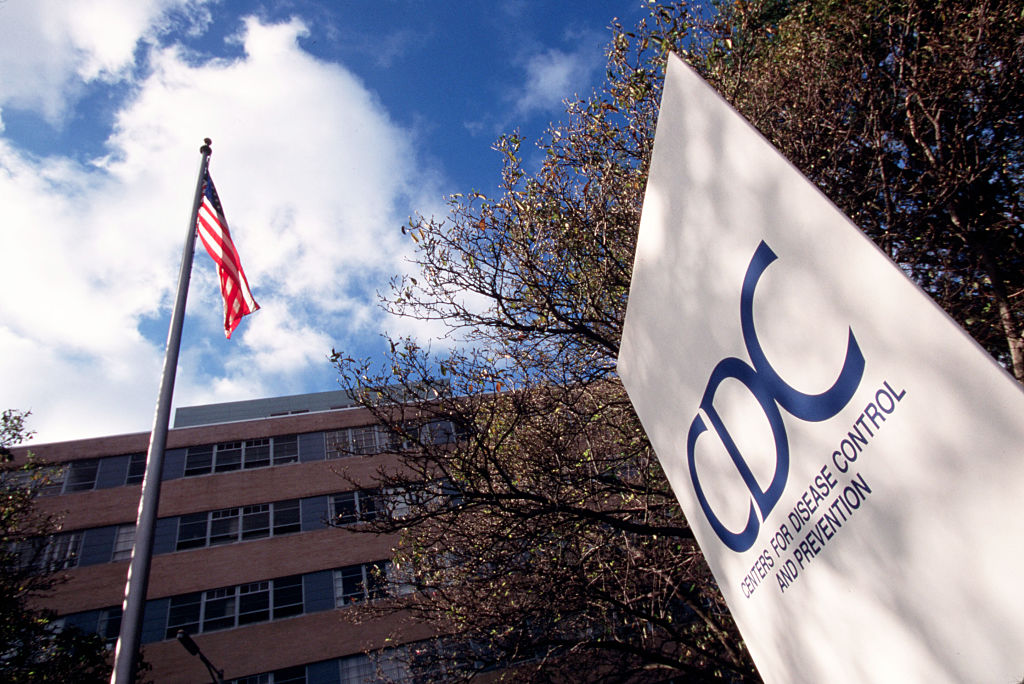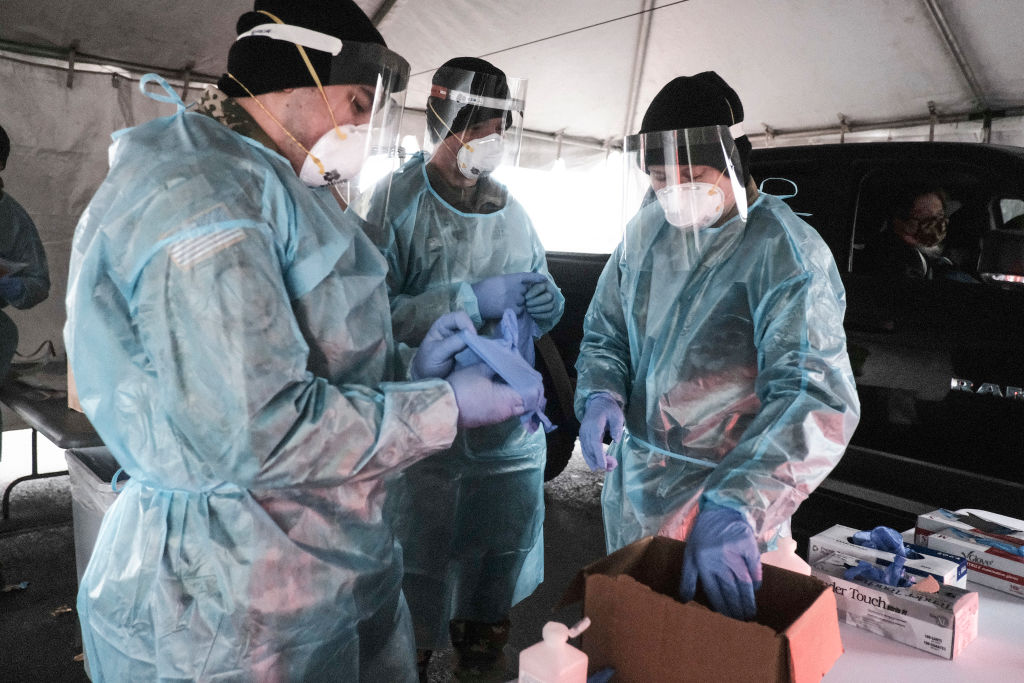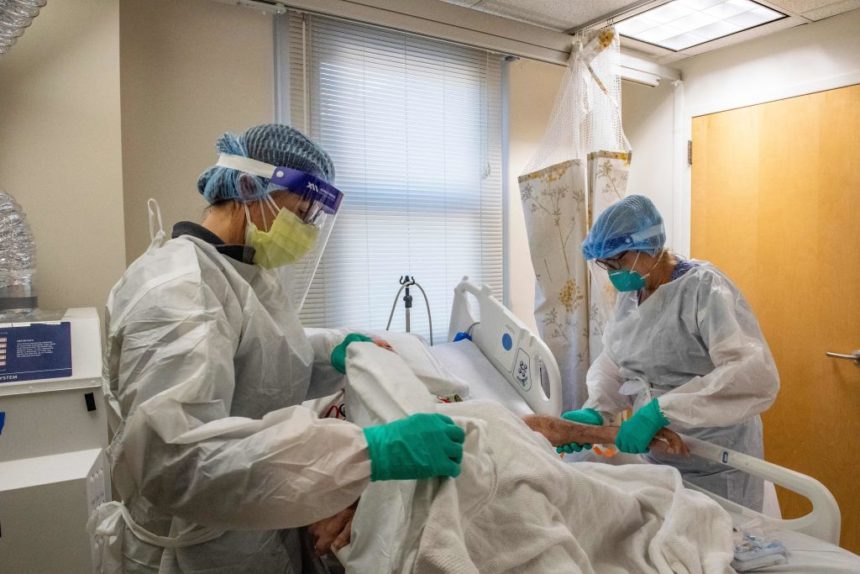Henry David Thoreau, who disappeared to Walden Pond in 1845 and spent two years there contemplating life, advised us to “simplify, simplify.”
In the world of COVID-19, that isn’t so easy. Less than two weeks into the third calendar year of a global pandemic, life remains complex and thorny.
The Omicron variant of the SARS-CoV-2 virus is sweeping across the country and the world, causing millions of infections. On January 5, more than 700,000 cases were reported in the U.S., more than doubling the daily peak seen a year ago, and the pattern continues. The 1.4 million cases reported on Monday reflects weekend accumulation, but represents a shocking sum nonetheless. Not surprisingly, transmission is high in 99.1% of counties.
Hospitalizations now top 140,000 and have climbed past the peaks of a year ago. This is not a new year’s pattern we want to repeat. Recent advice from public health authorities, seemingly as changeable as the virus, is, in the words of one health writer, “a dumpster fire.”
Less strident voices are urging us to acknowledge that COVID-19 is here to stay and we must learn to live with it. Three doctors who served on the Biden COVID-19 transition team say it’s time for a new national strategy, one in tune with a “new normal” of life with the virus.
Drs. Michael Osterholm (University of Minnesota), Celine Gounder (New York University) and Ezekiel Emanuel (University of Pennsylvania) urge leadership to move from “crisis to control” and to set clear guidelines for imposing and relaxing public health restrictions. Their opinion piece was one of three published in the Journal of the American Medical Association last week seeking to chart a pathway to what was once known as peaceful coexistence. Other authors focused on developing new vaccines and therapeutics and preparing for the next pandemic.
Some things are simpler than others, and some advice doesn’t change. Vaccination remains the most effective response to the pandemic in general and to Omicron in particular. One year into the vaccine era, however, we are still rolling that stone uphill.
Lest we lose track, here’s where we stand on the hill:
• 247 million people in the U.S. have received at least one shot, including 79% of the vaccine-eligible aged 5 and older and 86.5% of adults.
• 208 million are fully vaccinated (not including boosters), representing two-thirds of everyone 5 and older and nearly three-fourths of adults.
• 76 million have received a booster, including 40% of fully vaccinated adults. The Centers for Disease Control and Prevention began 2022 with a recommendation that everyone 12 and older get a booster.
• Immunocompromised people who have difficulty mounting a robust response to the vaccine are becoming eligible for a fourth dose.
The opportunity to vanquish the virus has evidently come and gone. While adults and especially seniors have achieved respectable rates of being fully vaccinated (73% and 88%, respectively), the rate for the entire population, 62.6%, is “dismal” in the view of former Surgeon General Dr. Jerome Adams, and a far cry from the 80% or 90% needed for herd immunity. Dr. Adams, in an op-ed in the Washington Post, says the vaccination campaign has suffered from “poor luck and poor effort.”
The health policy experts writing in JAMA say we won’t get to 90% vaccine coverage without mandates, which “have been shown to be effective, especially among individuals who are not fundamentally opposed to vaccination but are procrastinating, confused, or have barriers to access.”
What happens now? We can’t hide away at a pond for a couple of years. In the interest of simplifying, here are 10 thoughts for the week.
10. Vax on, vax off?
Those closely following oral arguments before the U.S. Supreme Court get the feeling that the justices may look kindly on the Biden vaccination mandate for healthcare workers and not so kindly on the get-vaccinated-or-get-tested requirement for businesses with 100 or more employees. The latter technically took effect on Monday but is realistically in limbo for now.
As Kimberly Marselas and James M. Berklan report in McKnight’s Long-Term Care News, the mantra for health workers in facilities funded by Medicare and Medicaid could well be “Get vaxxed or get axed.”
Elsewhere in mandate-land:
• The government is preparing to take disciplinary action against employees who have not complied with a separate vaccination mandate for the federal workforce
• The U.S. Postal Service is seeking a 120-day delay in vaccination requirements, a special delivery all its own
• The Louisiana Supreme Court has upheld a vaccination mandate imposed by Ochsner Health, a system with 30,000 employees.
• Another huge health system with a mandate, Mayo Clinic, is firing about 1% of its staff (700 of 73,000) for noncompliance. Ochsner has also terminated about 1% of its workforce.

9. The words get in the way
• The CDC’s new guidance on when to return from isolation and quarantine was roundly criticized for its omission of a testing requirement. That guidance has now been modified, sort of.
• The full set of isolation and quarantine guidelines runs six printable pages on the CDC website and, blessedly, is summarized in a helpful table. Be advised: “These recommendations do not supersede state, local, tribal or territorial laws, rules and regulations, nor do they apply to healthcare workers for whom CDC has updated guidance.”
• If you’re like us, you have enough trouble sorting out the difference between isolation (for people who get infected by the virus) and quarantine (for people who get exposed to people who got infected). It’s also hard to parse the difference between being “fully vaccinated” (for now, defined as two shots of Pfizer or Moderna or one of J&J) and being “up to date” on vaccines (having your booster).
• Former CDC director Tom Frieden, channeling Thoreau, told NPR recently that the content of public health messaging must be “clear, simple, technically sound and practical” in the real world.
8. Actions speak louder than words
• Bank of America is donating $100 to a local food bank for every US employee who receives a COVID-19 booster shot.
• Newsweek reports that Walmart, working quietly with community leaders, has effectively persuaded some of the most vaccine-averse groups – evangelicals, Trump voters and African Americans – to roll up their sleeves. “The lesson is clear: It helps everyone feel respected when community members become active participants in addressing the concerns of vaccine reluctance.” This was a central tenet of the Ad Council campaign and White House strategy announced a year ago: Trusted. Local. Messengers.
• Some employers, such as IKEA, are scaling back sick pay for unvaccinated workers. Such policies, however, are fraught with legal risks, Francis Churchill writes in People Management.
7. Help is on the way
• The ubiquitous spread of the Omicron variant is stressing emergency rooms, ICUs, hospitals in general and nursing homes, not to mention frontline workforces depleted by illness.
• Staffing is short-handed at the worst possible time. At least 10 states have called in National Guard troops to help with the load, CNN reports. FEMA sent 20 first responders to the University of Vermont Medical Center to help with the surge.

6. School’s in, or out
• Many schools are trying to stick to their new year’s resolution of keeping classrooms open for in-person instruction. Not so in Chicago, the nation’s third largest school system, where classes shut down for four days after the teachers union voted to reject in-person learning. After a “contentious weeklong standoff” between the union and the mayor, classes are back in session as of today.
• Around the country, schools are struggling to stay open amid Omicron outbreaks. There’s a ripple effect, in that school closures challenge the best-laid plans of parents returning to the workplace, Diana Bradley reports in PRWeek.
• Will vaccinating kids help quell outbreaks in schools? It is virtually a moot question in 17 states that have passed laws forbidding school vaccination mandates, according to the National Academy for State Health Policy.
• In New Jersey, a parents group is suing to prevent schools from switching from in-person to remote learning, claiming that it violates the rights of students with disabilities.
5. Kids hold the key
When it comes to getting kids vaccinated, parents are the primary decision makers and pediatricians and other caregivers the trusted local messengers. So far, results are mixed at best.
• On November 2, the CDC recommended COVID-19 vaccination of children ages 5 to 11. As of January 5, just 25% of kids in that age group have received at least one COVID-19 shot, which leaves 20 million children unvaccinated. Rates in individual states swing from 9% to 57%.
• For adolescents, who have been vaccine-eligible since December 2020 (ages 16 and 17) and May 2021 (ages 12 to 15), 63% have received one shot and 53% are fully vaccinated.
• Stay tuned as some school vaccine mandates are on the way; they may change the algebra.
4. My Flurona?
Misinformation continues to abound. While the twindemic of flu and COVID-19 is a real possibility, the metaverse and twitterverse and other verses (the converse?) lit up with claims that the two viruses have combined to form a supervirus. The only problem with this theory? It’s not true.
• Dr. Raghu Adiga, chief medical officer at Liberty Hospital in the Kansas City metro area, sets the record straight in Scientific American. He laments that scientists can’t communicate clearly and simply enough to compete with the frantic clamor of social media.
• Betty White can’t even die in peace. Among the social media falsehoods was the assertion that she received her COVID-19 booster three days before she died. This just in: she had a stroke six days before her death.

3. Temperatures rising
Wintry blasts of January notwithstanding, tempers are hot and flaring in a world on edge. In Melbourne, Australia, two professors at Monash University have written a 250-page open-access book, “Recovering Civility during COVID-19.” It’s a quicker read than you think, with more than 100 pages of references. In it, authors Matteo Bonotti and Stephen Zech suggest that recapturing civility – can we call it kindness? Thoreau might have called it Civil Obedience – is just as important to our pandemic response as vaccination and public health measures.
2. The numbers don’t lie, but what do they mean?
• If Flurona is one word we’re hearing, another is “decoupling,” which has nothing to do with the divorce rate. It means that, with the (theoretically milder) Omicron, massive numbers of cases won’t automatically translate into massive numbers of deaths. At least so far.
• We now have another semantic and numerical challenge to grapple with: The difference between those hospitalized for COVID and hospitalized with COVID. Many people admitted to the hospital for another reason – heart attack, broken bones, you name it – are testing positive for SARS-CoV-2 during routine inpatient checks. They’re calling it “incidental COVID.” Truly, nothing is simple.
1. The whole world is watching.
Haters gonna hate and variants gonna keep emerging as long as much of the world remains unvaccinated. The World Health Organization has been consistent in its messaging all along: Failing to reach global vaccination goals in 2021 was “a moral shame, it cost lives and provided the virus with opportunities to circulate unchecked and mutate…Ending health inequity remains the key to ending the pandemic.”
Parting shot
What is the “new normal,” anyway? Maybe it’s the filled parking lot at the ShopRite in my town of New Milford, NJ. Maybe it’s packed football stadiums (other than MetLife last Sunday, social distancing facilitated by a 4-13 football team).
At the same time, in yet another pandemic pivot, indoor mask mandates are making a comeback and high-profile public events (the Grammys, the Westminster Dog Show, the Sundance Film Festival) are being postponed or going virtual. Cruise ships are docked; National Hockey League players will skip the Winter Olympics in Beijing next month.
Thoreau eventually returned from Walden Pond to a “normal” life of writing essays, walking in the woods, working in the family pencil factory and serving as a conductor on the underground railroad. He died at age 44 of tuberculosis but not before penning (or penciling) these words: “If one advances confidently in the direction of his dreams, and endeavors to live the life he has imagined, he will meet with success unexpected in common hours.”
These are not common hours, but let’s see if we can advance confidently and meet with success unexpected. It’s worth the effort.
…and some songs
What Do The Simple Folk Do? Julie Andrews and Richard Burton (from Camelot)
Take care, be well, stay warm. Thanks so much for joining us. See you next week. May the Omicron wave soon break upon the shores.








